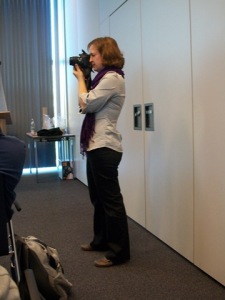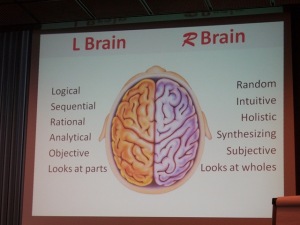The 3rd day had also many good sessions, it started with key note “The One Thing You Need To Know” by Mary Poppendieck. She mentioned there are three rules of Lean Development (as in the picture below) : Design / Construct / Learn.
First is the “design”. We should focus on the whole system, value system / ecosystem / user experience system, kind of that, instead of just the software, which easily keeps us far away from the real user needs. In order to design the right system, we could first understand what users really want; then observe how people use it and their reacts; modeling the understandings, draw the ideas as a whole; finally experiment the ideas, be prepared to inspect and adapt.
Then it’s the “Construct”, Mary pointed out the fact that many companies use a hardening period before actual release. The earlier they need to start hardening, the less and later integration they did, but actually we should try to work on verify the system behaviours as early as possible. Of course we had several practices supporting that, e.g. continuous integration.
However, the two case studies from Grain Monitoring System and Agile@IBM showed that start verifing the correctness earlier improved the final quality, by discovering bugs earlier and fixing earlier, by having more feedback faster. We all know that how much a later found bug costs more than found early. The only way out is building the quality in from the start.
Obviously learning is very important, many people talk about it and mention as the key factor of Agile devleopment success. Don’t be afraid of failures, face them, analyze them, and learn from them, be stronger the next time. Learning by doing, inspect and adapt, it’s so simple, and so hard at the same time.
“Learning is key to Agile success” by Declan Whelan
I love this session! Even there’s no real working experience from Declan was a pity, but the topic was really good, and his material was organized excellent, also the way he presenting was so experienced.
One thing I’m not so happy about the presentation was he thought this two characters were Japanese words, which were actually Chinese old characters, check some examples from :



Here’s the overview of his topic, and the photographed photographer 🙂
Declan quoted a lot from Peter Senge’s book “The Fifth Decipline” and others, which I thought very good. Software development was not specific from people point of view, if there are people, we have to manage or use the leadership skill. We definitely need to learn management or leadership or people-related skills.
In the slide “What Do We Need To Learn?”, he summarized nicely those things. It exactly explained the question I always ask people back when they talk about competence development, “how do you define competence?”. People focus on domain knowledge too much, tend to ignore other parts, that they also need to understand what their customer really want, the techniques they need to master, the teamwork skills and so on. Together with “How Do We Learn?” and “L Brain & R Brain”, it told us it’s not an easy job to learn, people learn in different ways, e.g. I learn better in live interactive style.
After explained the “Beginner’s Mind”, he did one exercise, I had be honest that I’ve never thought he’ll use it in that way. A beginner opens for more possibilities, while expert has limited frames (the term Mary used). Declan asked us to draw a hand, then asked the question “how many of you actually looked at your own hands?”. Which is very tricky, that exactly explained we felt we already had it in our mind, but forgot to look at the real hands and draw according to that.
His personal “Learning Culture Map” was interesting, especially how he split the Chinese words and gave meanings to them. “Intentional” for how to do conscious learning, the methods we could learn or increase knowledge; “Infrastracture” was how we organize and manage time to used use those learning methods; “Incremental” is about how to keep knowledge accumulate; “Individual Safety” is a must for the learning culture, people tend to cover failures and incompetences if they don’t feel safe.
He deserves the applause at the end.




























Pingback:Scrum/Agile Starter Kit | BE AGILE & LEAN